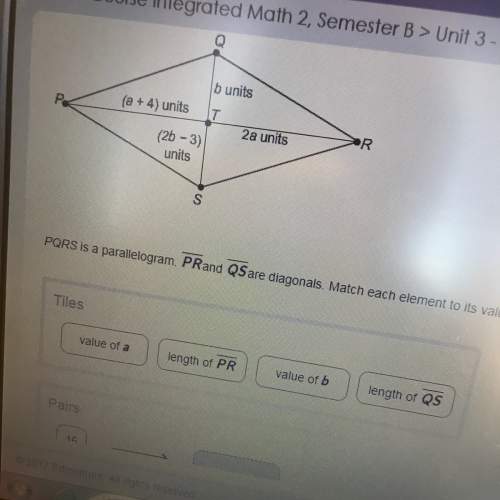Ineed asap
question: pqrs is a parallelogram. pr and qs are diagonals. match each ele...

Mathematics, 01.01.2020 16:31 janayshas84
Ineed asap
question: pqrs is a parallelogram. pr and qs are diagonals. match each element to its value
pairs:
16 > ?
4 > ?
> ?
6 > ?


Answers: 3
Another question on Mathematics

Mathematics, 21.06.2019 14:30
Suppose the radius of a circle is 16. what issuppose the radius of a circle is 16. what is its circumference its circumference
Answers: 2

Mathematics, 21.06.2019 17:10
Determine whether the points (–3,–6) and (2,–8) are in the solution set of the system of inequalities below. x ? –3 y < 5? 3x + 2 a. the point (–3,–6) is not in the solution set, and the point (2,–8) is in the solution set. b. neither of the points is in the solution set. c. the point (–3,–6) is in the solution set, and the point (2,–8) is not in the solution set. d. both points are in the solution set.
Answers: 3

Mathematics, 21.06.2019 20:00
The boiling point of water at an elevation of 0 feet is 212 degrees fahrenheit (°f). for every 1,000 feet of increase in elevation, the boiling point of water decreases by about 2°f. which of the following represents this relationship if b is the boiling point of water at an elevation of e thousand feet? a) e = 2b - 212 b) b = 2e - 212 c) e = -2b + 212 d) b = -2e + 212
Answers: 1

Mathematics, 21.06.2019 21:30
In a test for esp (extrasensory perception), the experimenter looks at cards that are hidden from the subject. each card contains either a star, a circle, a wave, a cross or a square.(five shapes) as the experimenter looks at each of 20 cards in turn, the subject names the shape on the card. when the esp study described above discovers a subject whose performance appears to be better than guessing, the study continues at greater length. the experimenter looks at many cards bearing one of five shapes (star, square, circle, wave, and cross) in an order determined by random numbers. the subject cannot see the experimenter as he looks at each card in turn, in order to avoid any possible nonverbal clues. the answers of a subject who does not have esp should be independent observations, each with probability 1/5 of success. we record 1000 attempts. which of the following assumptions must be met in order to solve this problem? it's reasonable to assume normality 0.8(1000), 0.2(1000)%30 approximately normal 0.8(1000), 0.2(1000)% 10 approximately normal srs it is reasonable to assume the total number of cards is over 10,000 it is reasonable to assume the total number of cards is over 1000
Answers: 1
You know the right answer?
Questions

Geography, 26.09.2019 22:00

Social Studies, 26.09.2019 22:00



English, 26.09.2019 22:00

Mathematics, 26.09.2019 22:00


Chemistry, 26.09.2019 22:00

History, 26.09.2019 22:00



Biology, 26.09.2019 22:00

Mathematics, 26.09.2019 22:00

English, 26.09.2019 22:00

Mathematics, 26.09.2019 22:00


Mathematics, 26.09.2019 22:00



Mathematics, 26.09.2019 22:00



